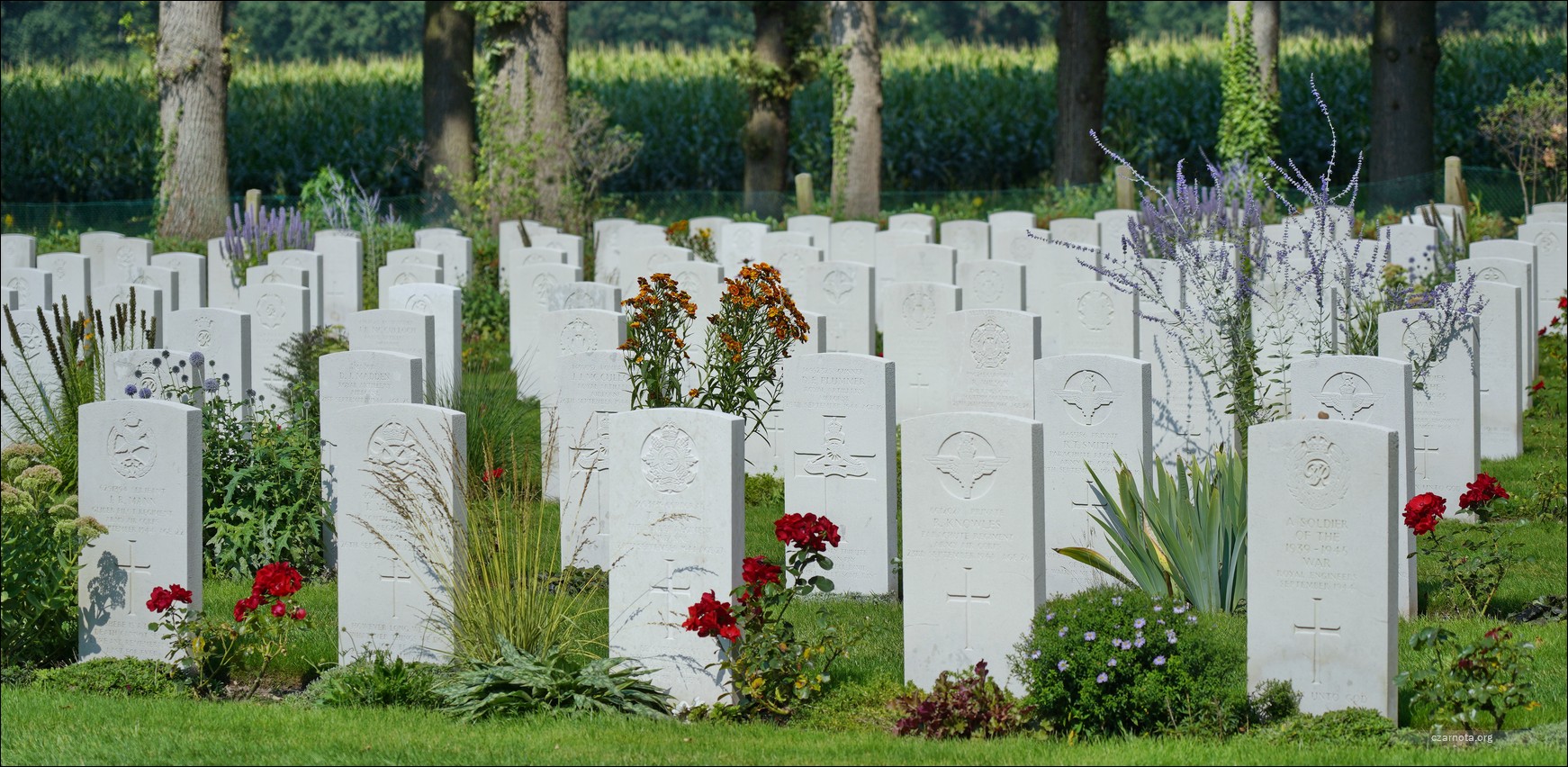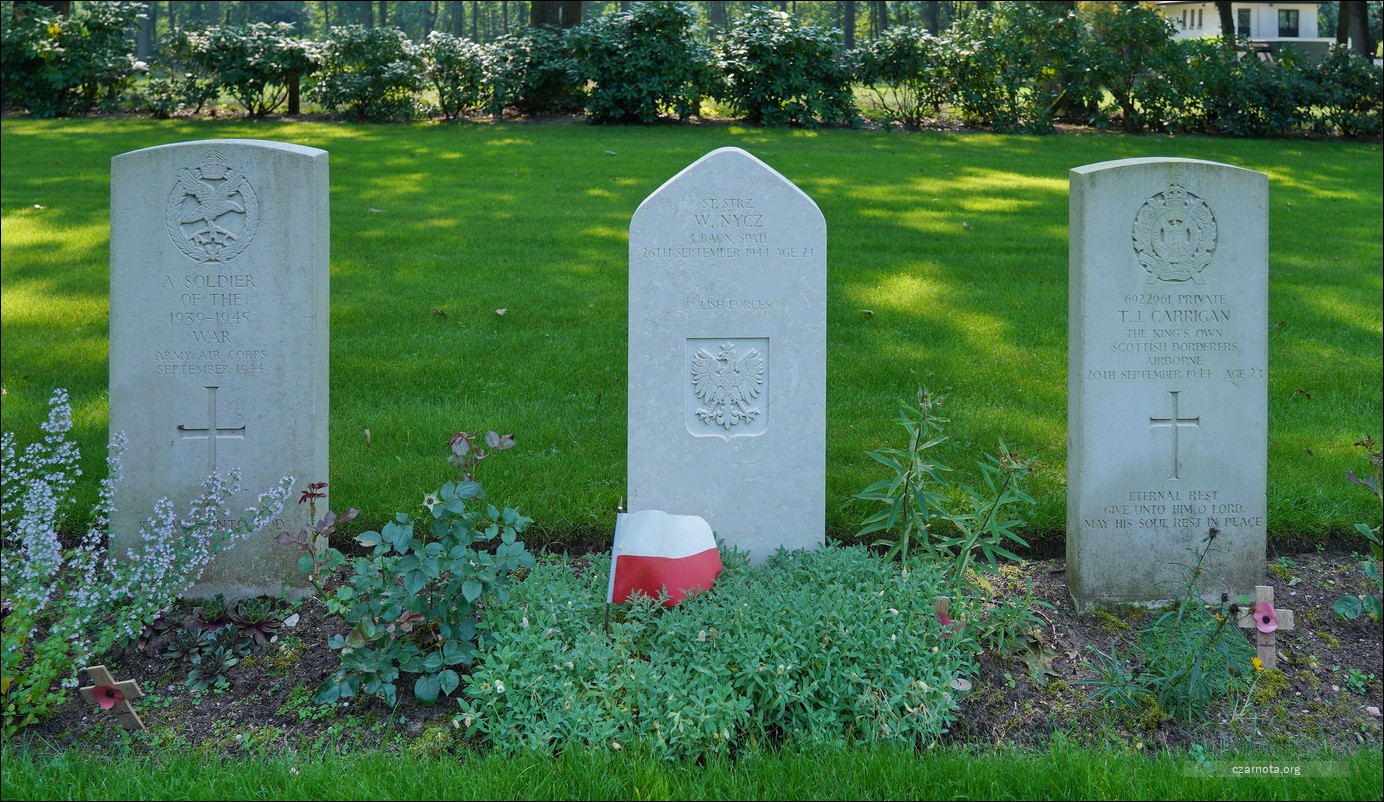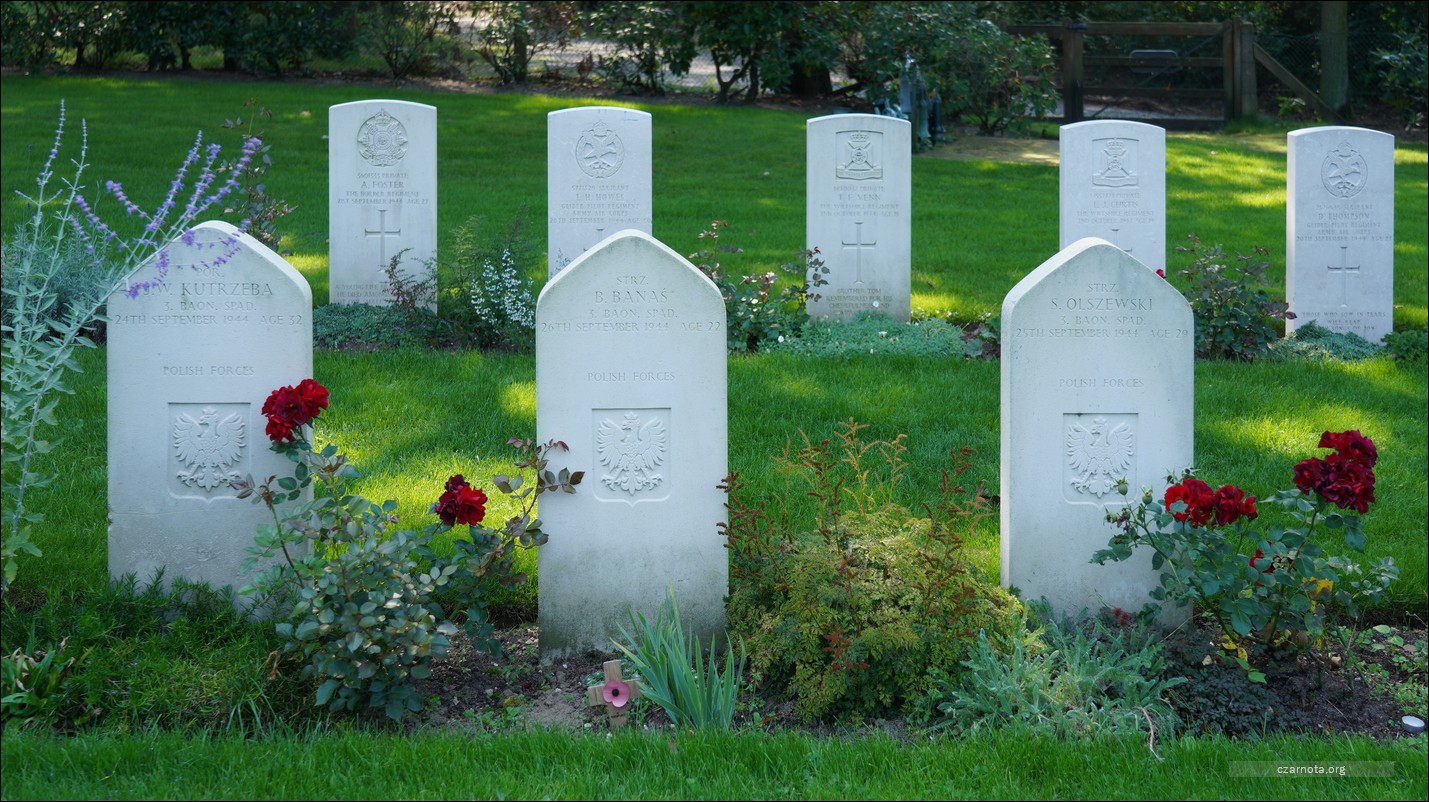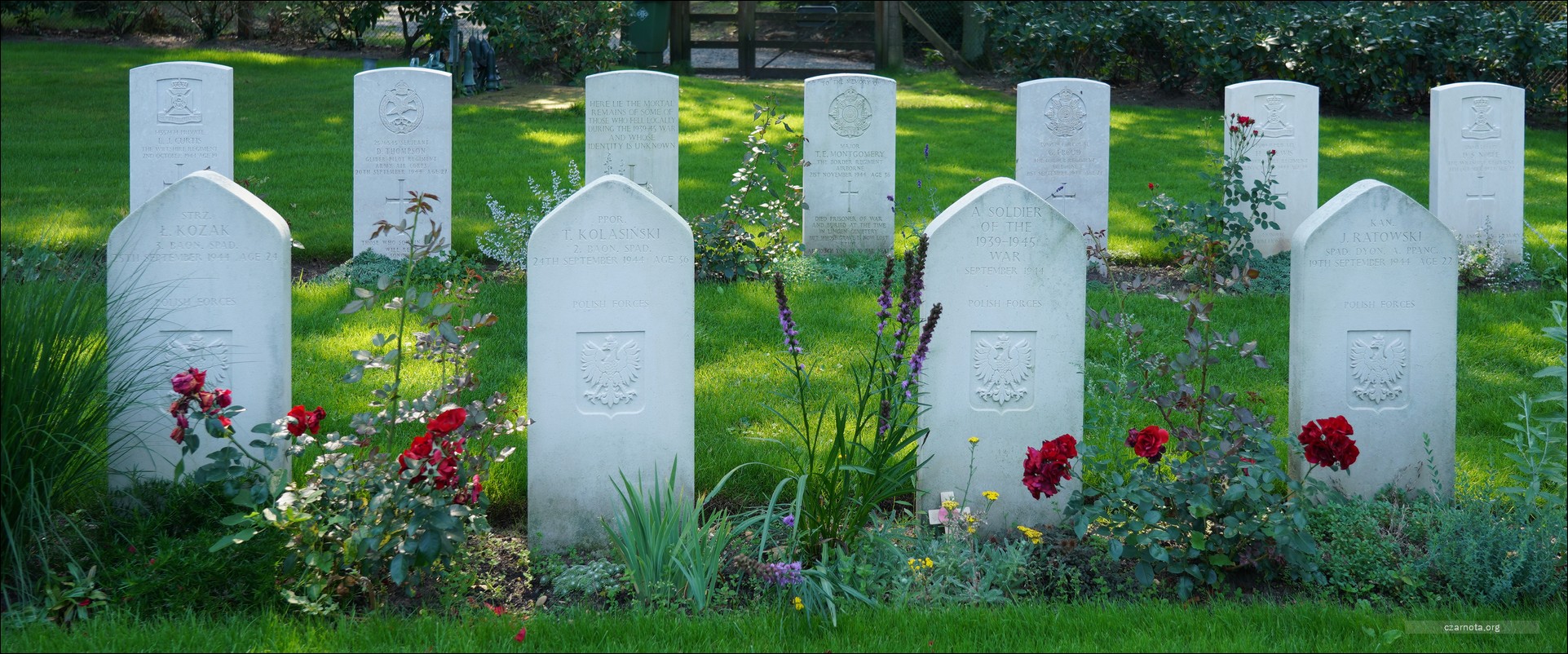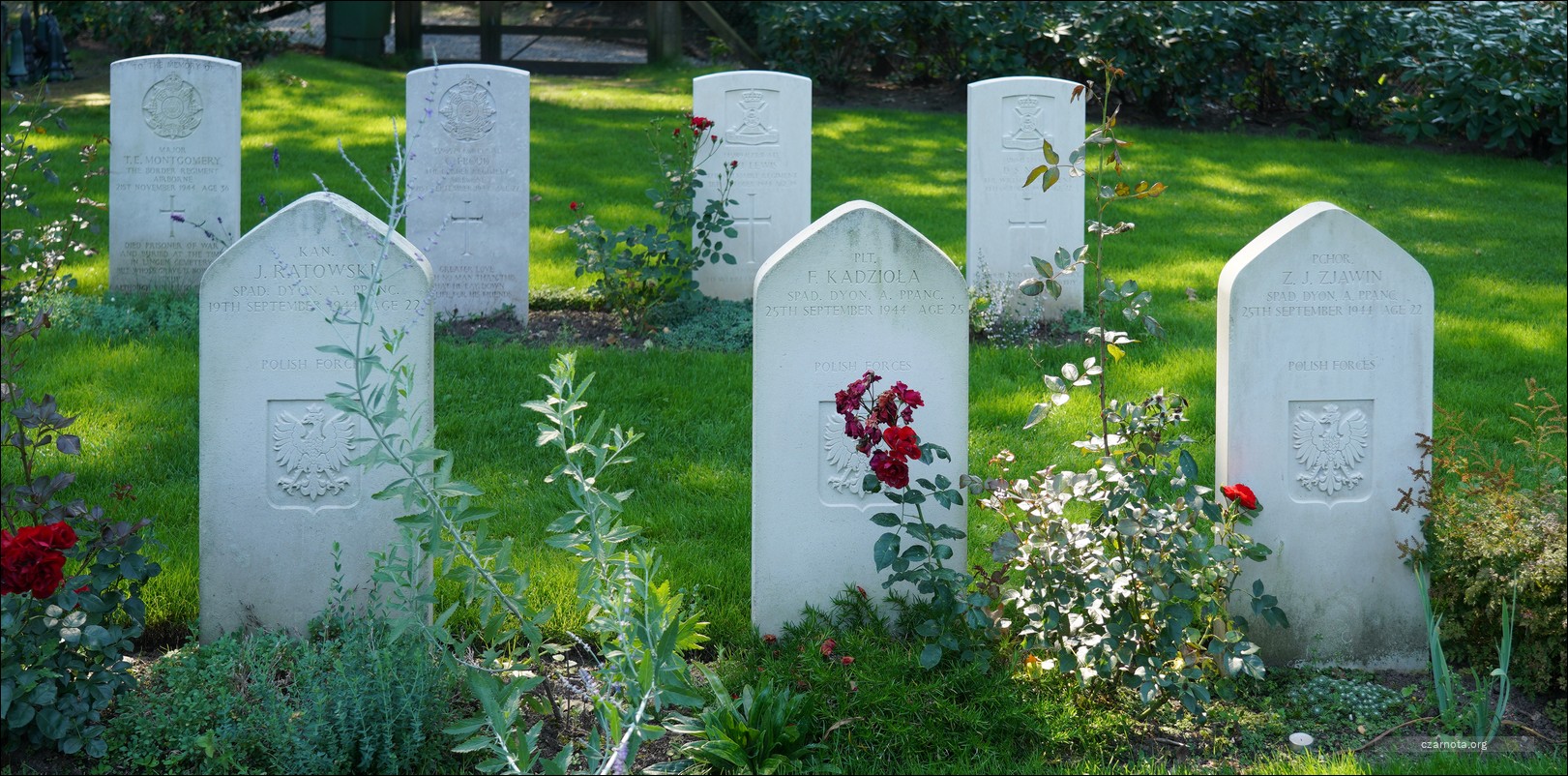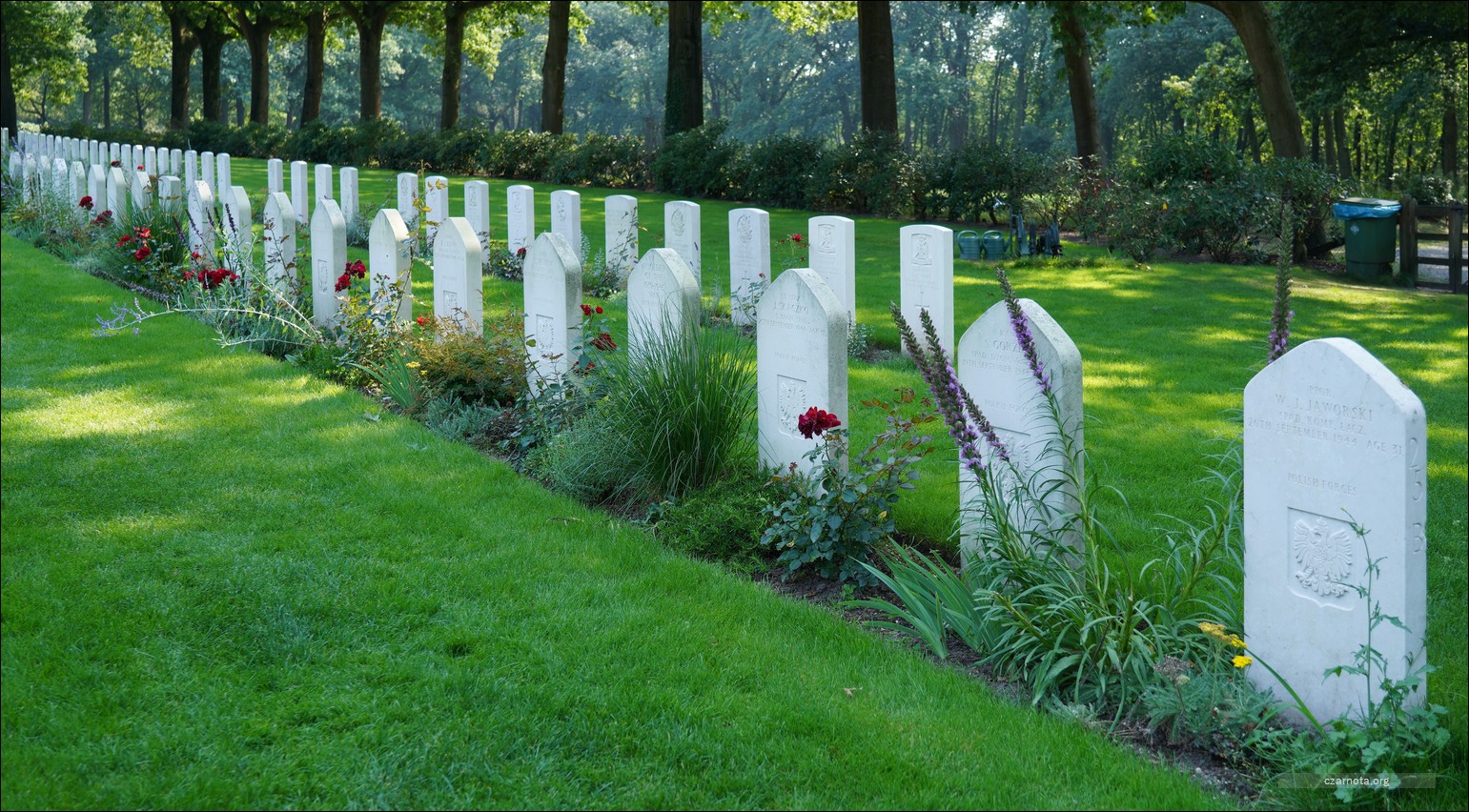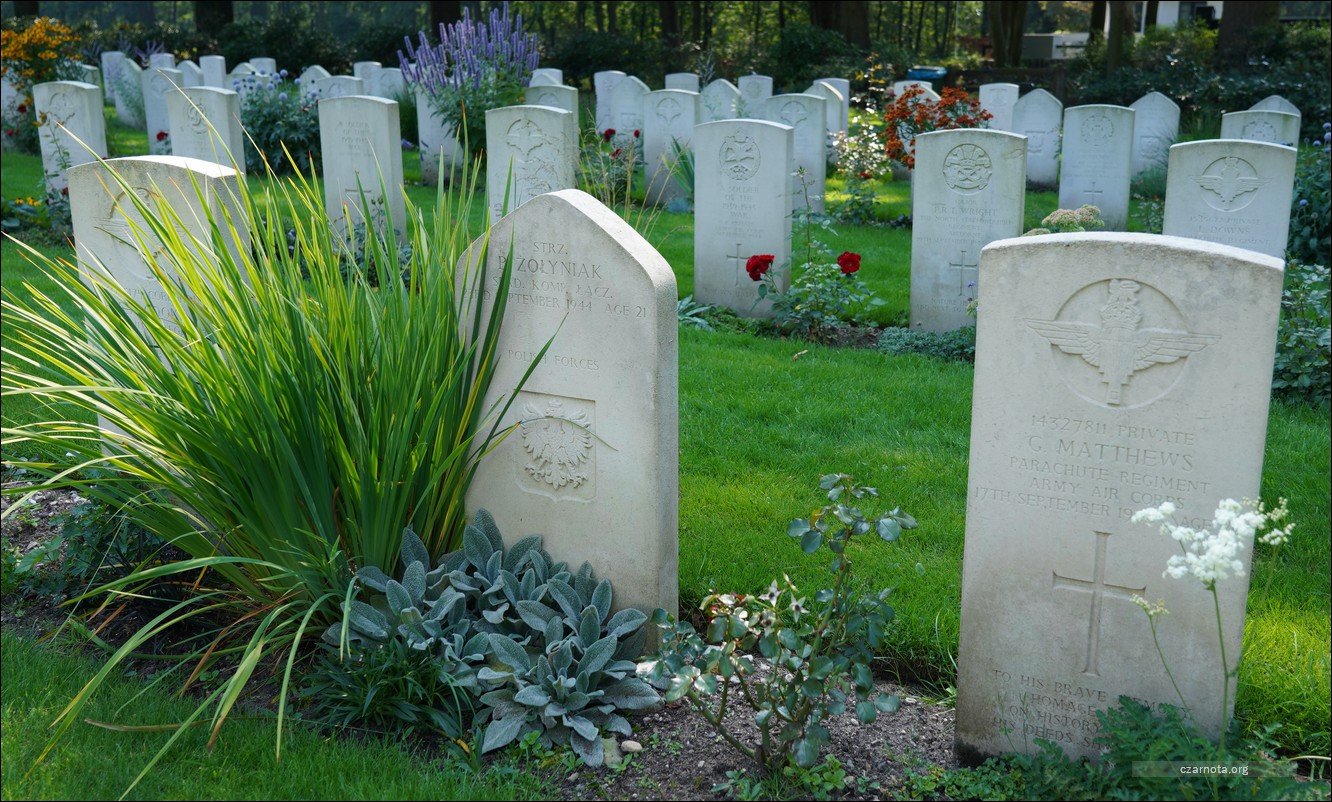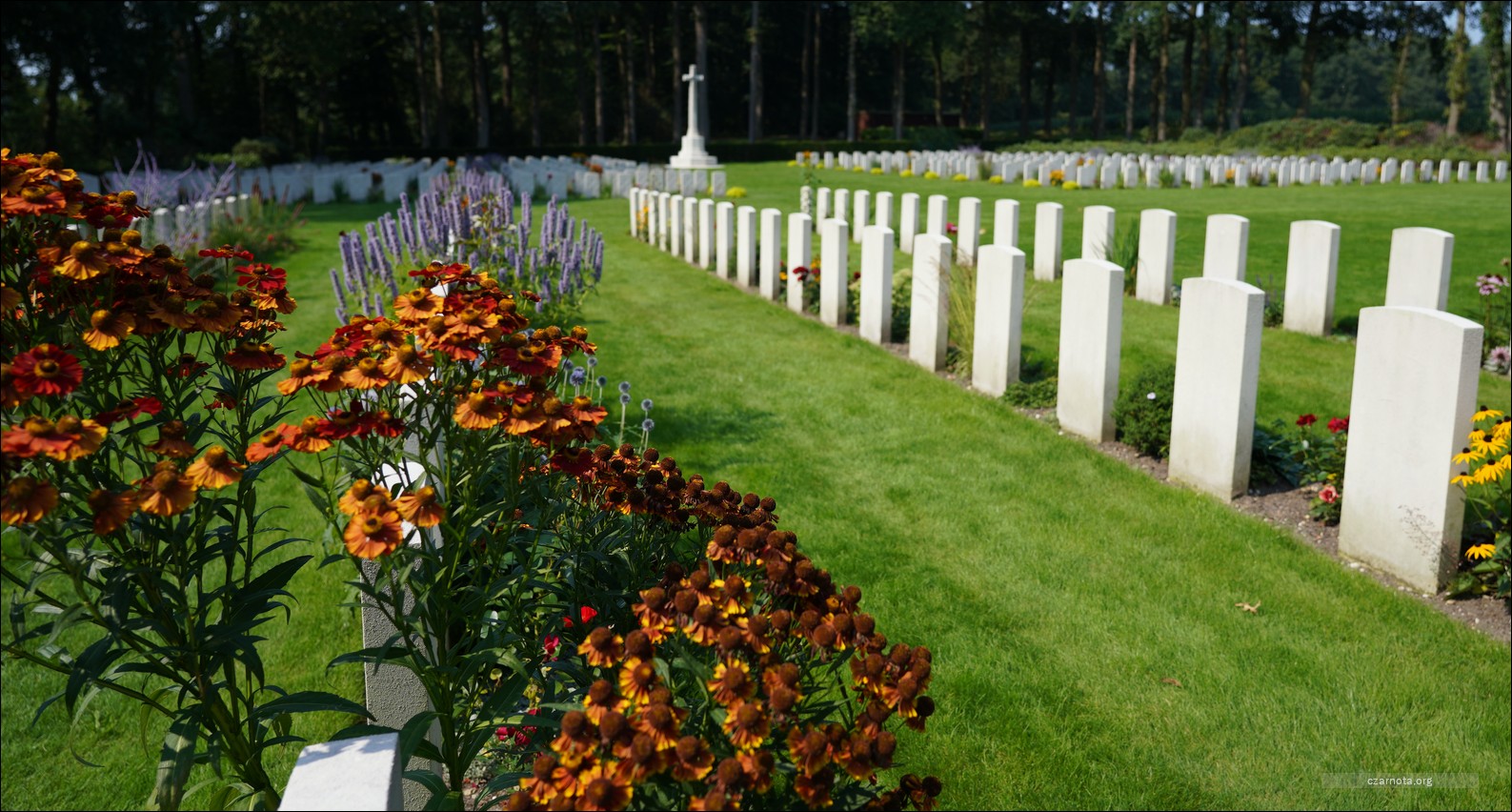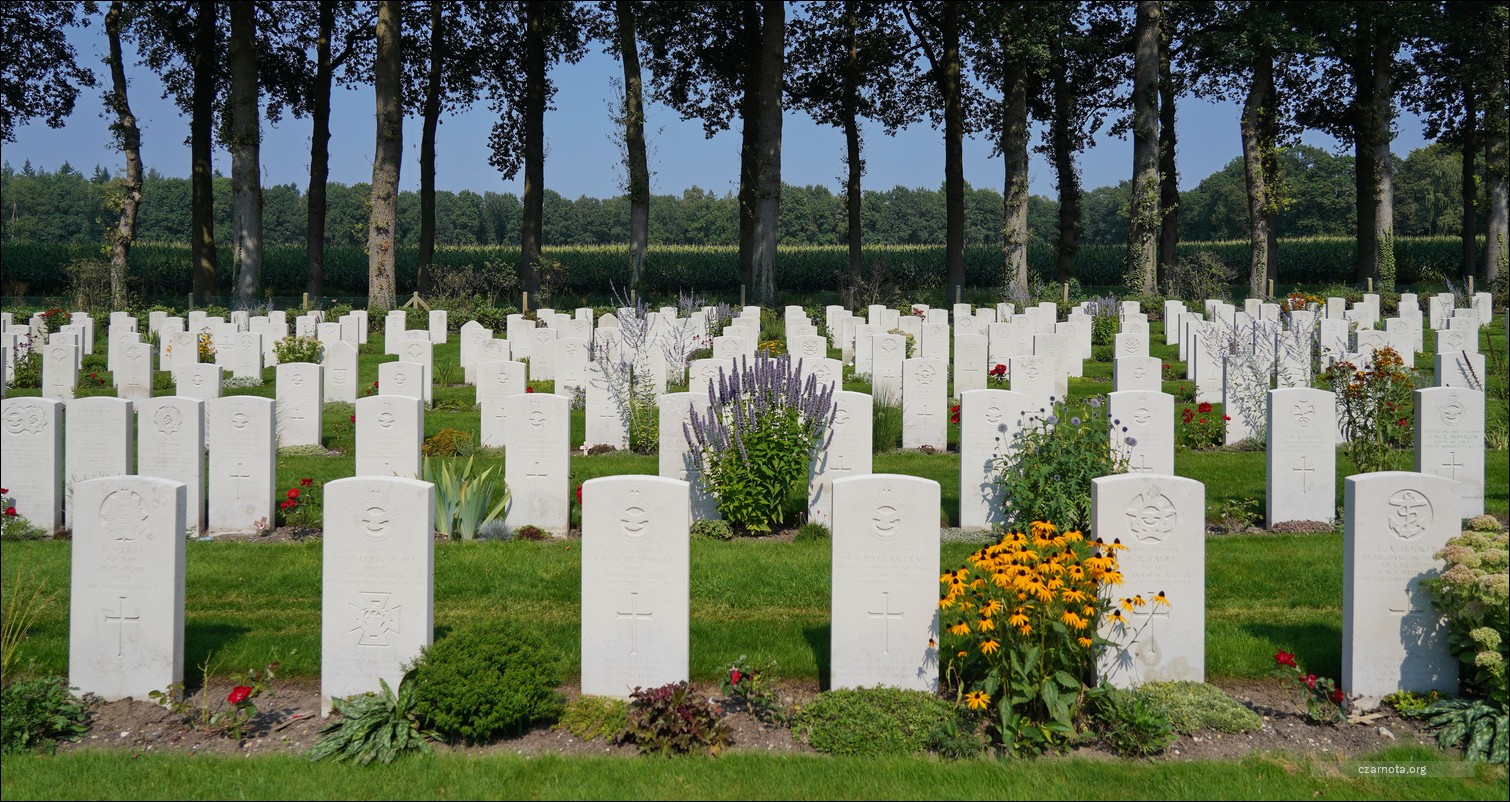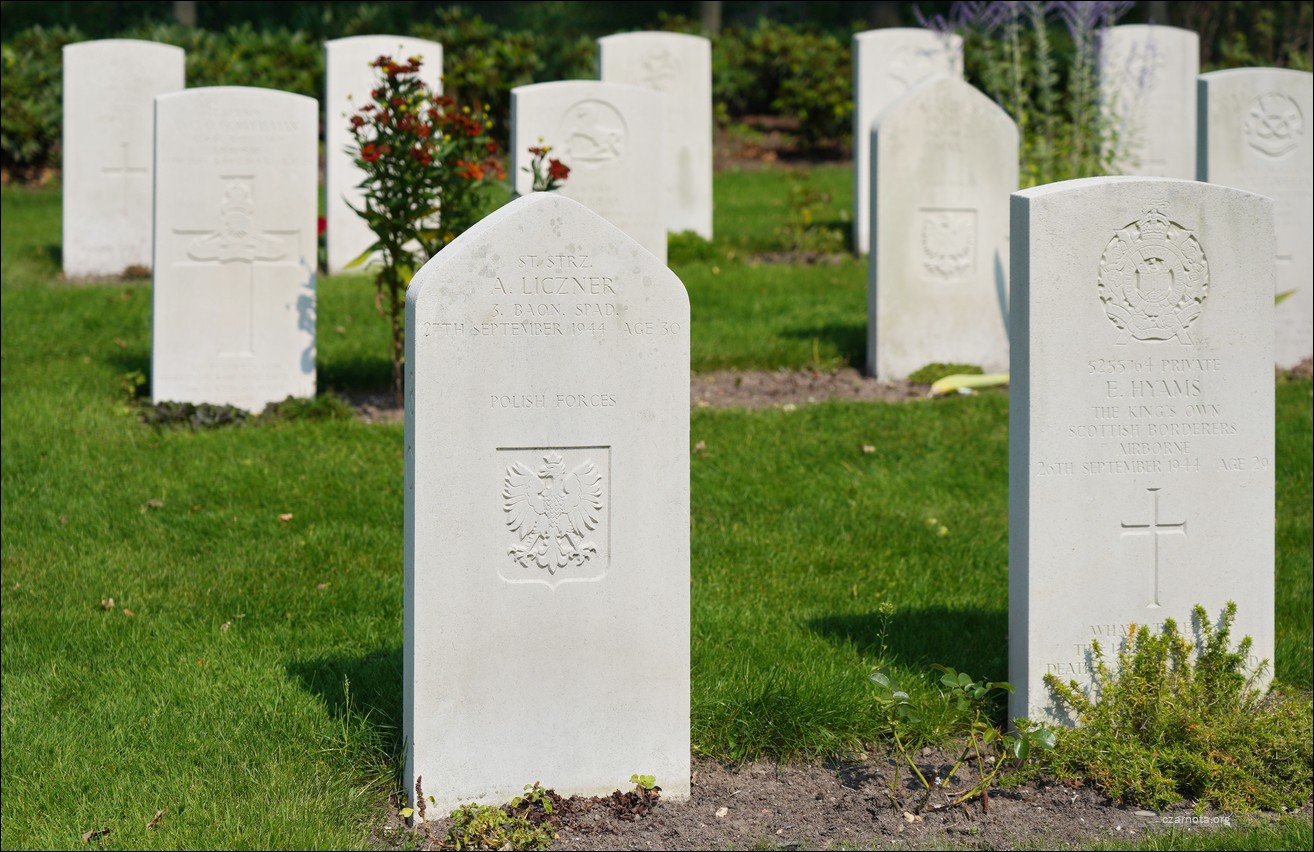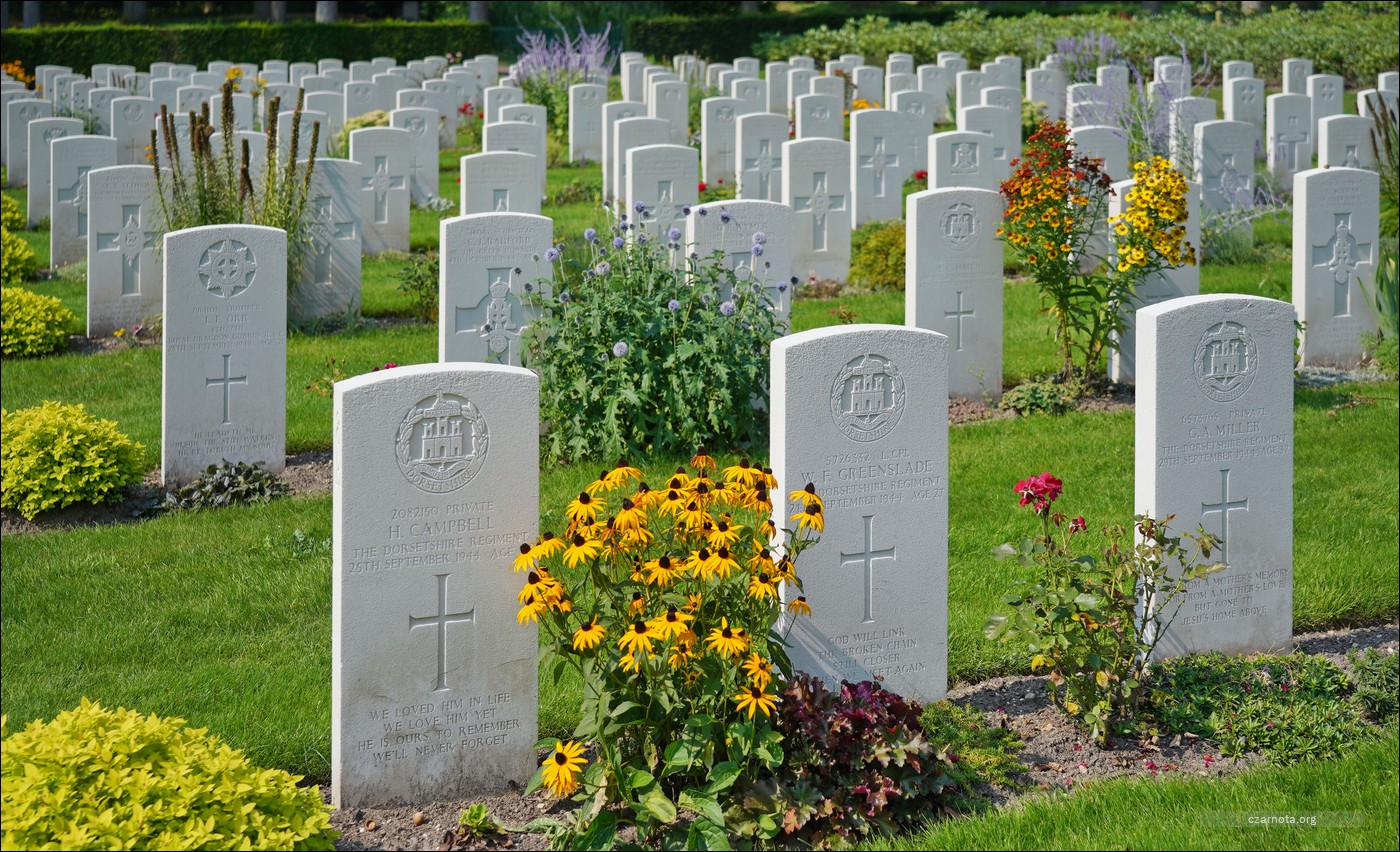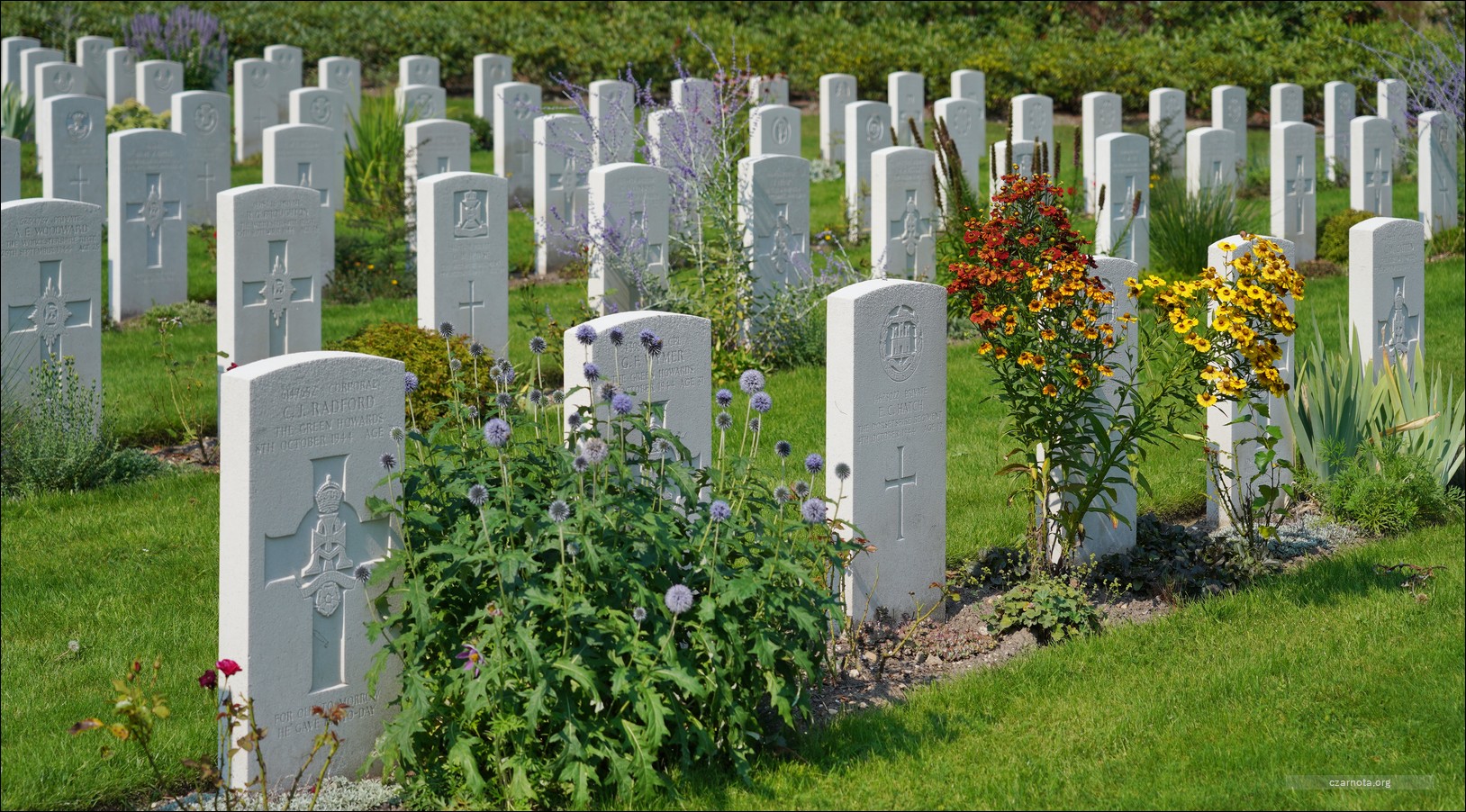Brama cmentarza Arnhem Oosterbeek War Cemetery

Do walki w operacji Market Garden została skierowana sformułowana w 9141 roku
– pierwotnie z planem udziału w walkach o wyzwolenie kraju 1 Samodzielna Brygada Spadochronowa.
W ciężkich bojach pod Arnhem bohaterska brygada poniosła znaczne straty – ponad 90 poległych
Autorem projektu cmentarza jest architekt CWGC Philip Hepworth.
W odróżnieniu od standardowych cmentarzy wojennych Wspólnoty Brytyjskiej, w Oosterbeek groby zgrupowano z uwzględnieniem jednostek i ról w walce –
w oddzielnych sektorach pochowano spadochroniarzy, żołnierzy sił lądowych, pilotów szybowców desantowych i załogi RAF.
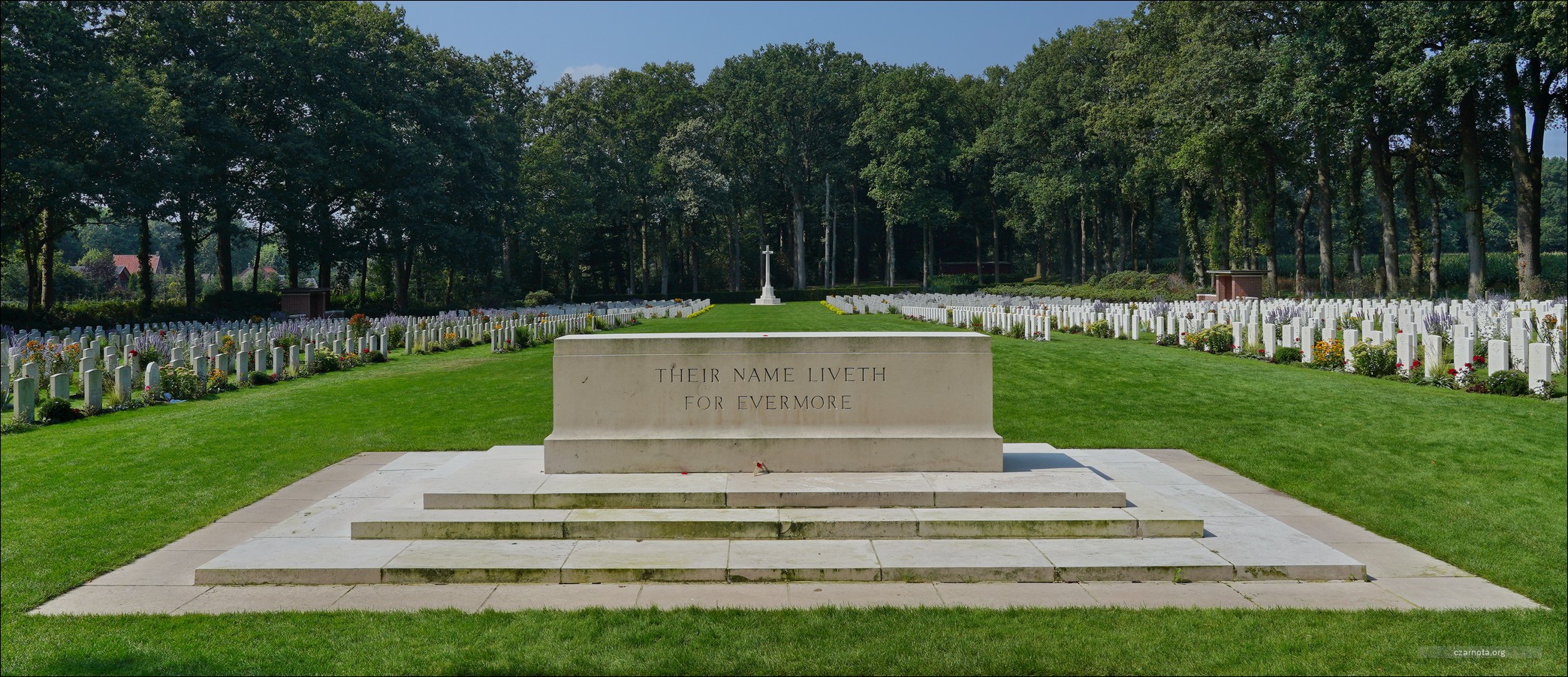
Nagrobki polskich żołnierzy położone na północ od bramy cmentarza

Nagrobki polskich żołnierzy położone na południe od bramy cmentarza

Starszy Strzelec Podchorąży IGNACY J. ŻEBROWSKI
Polish Army, I Batalion Spadochronowy

Photo added by Martin Carrack https://www.findagrave.com/memorial/122468481/stanislaw-klapouchy
Starszy Strzelec STANISŁAW KŁAPOUCHY
Polish Army, I Batalion Spadochronowy
https://www.bbc.co.uk/history/ww2peopleswar/stories/22/a2783522.shtml
From Siberia to Arnhem via Scotland
As told to a daughterWhen war is declared in September ’39, Franek Zimnowlocki, my dad, is celebrating his seventeenth birthday. His father immediately joins the Polish forces leaving Franek in charge of the rest of the family – his mother, four sisters and two brothers, one a baby. They remain in the village of Stasin, near Lvov at the border with Russia.
On February the tenth 1940 Franek remembers being awaken by the NKVD (one of the predecessors to the KGB) just after four a.m. After searching for arms they give the family an hour to pack and they and the rest of the village are taken by sledge to Vlodzmierz, the nearest railway station. Franek says it was a keen frost, the snow very deep. With hundreds of other Poles they are herded into cattle trucks and set off to an unknown destination.
The train travels mostly by night. Occasionally two men are allowed out to collect hot water. After some two weeks the train stops and does not move on. Hundreds of Poles find themselves in deep forests east of the Urals. These people, old and young, hungry, cold and bewildered are housed in ready made barracks which were built many years ago as prison huts to accommodate Cossacks at the time of the Russian revolution.
There are twelve to fourteen families in each long hut. No partitions, no privacy, no cooking facilities. There are only dry latrines which drain into a stream, the nearest source of drinking water. The Poles settle down to this new and harsh life. I asked dad if felt frightened during all this. “Not frightened” he said, “everyone I knew was there, what I remember most was hunger”.
The able bodied are employed as wood cutters, the women, such as Franeks mother and fifteen year old sister, burn branches. There are no guards – there is nowhere to run. Within two months little Edward is dead. If you can’t work there is no food ration and mother is too malnourished to feed him. He is one of hundreds of babies to die of starvation at this time.
In the spring, due to the unsanitary conditions, typhoid sweeps through the region. Many families are wiped out. Even the Russians officials are not immune. Franek digs graves and remembers burying the baby of one the officials, who stood in tears making the sign of the cross over and over again. Franek himself catches typhoid and is hospitalised some fifteen miles away. My grandmother walks there every week, carrying nettle soup she has made herself. By a miracle, or nettle soup, he survives. On his recovery he is given light duties, driving the bread wagon through the camps. In this job he is able to steal bread and helps keep the family in what can be described as luxury rations.
In August ’41, because of the Russian concordat with the allies, an amnesty is declared. All able bodied Poles are invited to join the Polish army. Franek is faced with a dilemma – should he stay, he is the family bread winner (stealer ?) or join up and fight the enemy. His mother urges him to go and he made a decision that changed his life forever.
The Russian government offers no help to the Poles who decide to join up. With faith and hope, willpower and ingenuity, rafts are built and hundreds of young men and women with no equipment, supplies or by now no physical strength, set off down the river Ob. They dig potatoes from frozen fields and Franek tells of the theft of a pig. On reaching Slverdovsk they travel south, again in cattle trucks, to Tashkent. The new army is overwhelmed with volunteers and Franek’s group is sent by barge on the Amu Darya river to Samarkand. There they spend several months harvesting kapok, rice and maize. Hunger is still the biggest enemy and when local farmers grow angry about missing chickens and sheep, the Poles run away.
In January ’42 Franek is accepted into the army and travels to Kraznodzk and then by oil tanker across the Caspian sea to Pachlevi (Baku). By now typhoid and cholera are taking their toll on these weak and undernourished people. Franek remembers continual burials, night and day, in mass graves. Coffins are re-used as they try to cope up with the death rate. During the month of rest in Pachlevi, Franek is issued with a British uniform. His own clothing is burnt and he undergoes a complete de-lousing process. The survivors of this amazing journey are stunned to find food in every shop and that you can eat when and what you want. This is their first decent food in over two years. Franek says he once ate so many figs that they made his mouth bleed.
His journey continues to Palestine, another two weeks rest and then by lorry to Durban in South Africa. As a British soldier he boards HMS Franconia, guarding Italian prisoners of war and sails to Britain. Franek joins the first battalion of Polish paratroopers and is trained in Ely in Fife where he meets his future wife.
Having been wounded in action at the battle of Arnhem, he convalesces in Taymouth castle and marries his Scottish lass.
Epilogue
Growing up I heard very little of dad’s experiences. Only when my sons became involved in a school project about WW2, some forty years later and asked their papa if he’d “been in the war”, did Franek start to talk about this part of his life. He also told them of his comrade Stanislaw Klapouchy who was killed at Driel (the Polish landing area during the battle of Arnhem) in the same foxhole where dad was wounded. Dad forever felt guilty that he was the one to survive. Mr Klapouchy was buried in the war cemetery at Oosterbeek and Franek paid tribute to his comrade whenever he visited Arnhem. Dad died in 2001 and his ashes are buried alongside his comrade. May they both rest in peace.
Plutonowy-Podchorazy EDWARD KOSTRZ
Polish Army, I Batalion Spadochronowy

s. Law
Royal Army Service Corps Arirborne
Lieutenant J.A. Wellbelowe
Royal Canadian Inf. Coprs
NORMAN OLIVER WEAVER
The Parachute Regiment, A.A.C. 10th Bn.
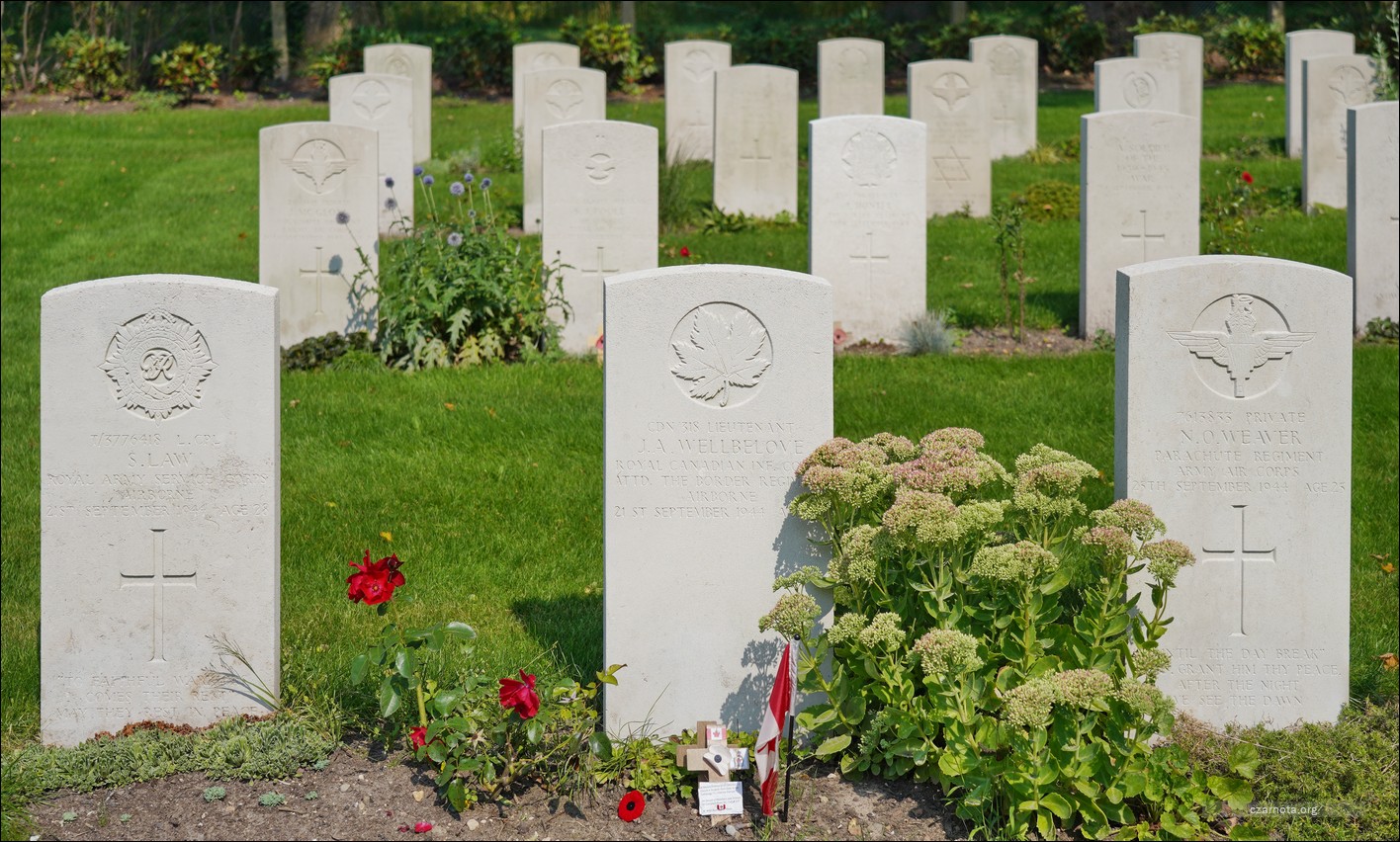
A soldier of the 1939-1945 war
Starszy strzelec Walenty Nycz

https://www.findagrave.com/memorial/114857468/walenty-nycz
3 batalion spadachronowy
Polish forces
Thomas Joseph Carrigan
King’s Own Scottish Borderers
7th Airborne Battalion
Lance Corporal Thomas John William Bryson
Border Regiment
Karol Edward Standarski

https://www.findagrave.com/memorial/114858043/karol-edward-standarski
Anti-Tank (Airlanding) Battery 1 Polish Independant Parachute Brigade Group Polish Forces
THOMAS McDONALD
Border Regiment
1st (Airborne) Bn.

THOMAS THOMPSON
Royal Army Medical Corps
133 Parachute Field Amb
A polish soldier of the 1939-1945 war
STARSZY STRZELEC
KONSTANTY WESOŁOWICZ
Dawid Salik był jednym z około 30 żołnierzy wyznania mojżeszowego, którzy walczyli w szeregach 1 Samodzielnej Brygady Spadochronowej w operacji Market- Garden. We wrześniu 1939 r. walczył w składzie 2 Pułku Strzelców Podhalańskich, uniknął niewoli i powrócił do rodzinnego Sanoka, a następnie przeniósł się do Leska skąd został przez Sowietów zesłany na Syberię.
Udało mu się dostać do Armii gen. Andersa, z którą opuścił ZSRR. Podczas pobytu w Palestynie zgłosili się do niego przedstawiciele żydowskiej organizacji „Hagana”, którzy chcieli namówić Salika aby wstąpił w jej szeregi, ten jednak odmówił, odpowidając iż jest Polakiem i polskim żołnierzem i zamierza wrócić do Polski, gdzie zostali jego rodzice.
Następnie Dawid został przetransportowany do Wielkiej Brytanii, gdzie zgłosił się na spadochroniarza do 1 Samodzielnej Brygady Spadochronowej. Przydzielony został do kompanii sanitarnej. Podczas operacji Market- Garden w stopniu kaprala skakał pod Driel dn. 21/09/1944 i był jednym z pierwszych polskich żołnierzy, którzy przedostali się na północny brzeg Renu. Tam zajmował się rannymi. Dowodząc grupą żołnierzy w Oosterbeek, w czasie intensywnych walk, rozkazał jednemu z nich Konstantemu Wesołowiczowi przeskoczyć z jednego budynku do drugiego. W czasie wykonywania rozkazu Wesołowicz poległ trafiony przez niemieckiego snajpera. To wydarzenie później przez długi czas bardzo ciążyło Salikowi, gdyż Wesołowicz poległ wykonując jego rozkaz. Tuż przed ewakuacją na południowy brzeg rzeki, obawiając się represji przy ewentualnym dostaniu sie do niewoli, zakopał swój złoty wisiorek z gwiazdą Dawida. Udało mu się ostatecznie uniknąć niewoli i łodzią opiekując się rannymi zdołał przedostać sie przez Ren. Po walkach został awansowany na sierżanta i otrzymał Brązowy Krzyż Zasługi z Mieczami. Po wojnie dowiedział się, że większość jego rodziny zginęła, zatem postanowił pozostać w Wielkiej Brytanii, gdzie pracował w handlu ostatecznie stając się właścicielem dobrze prosperujących londyńskich delikatesów. W Anglii rówież ożenił się, a w 50 rocznicę operacji Market-Garden wykonał nawet skok spadochronowy. Po wojnie odwiedzał Polskę, mimo że nie miał tam już nikogo z rodziny. Zmarł w 2012 roku.
https://www.facebook.com/historiaoktorejsieniemowi/posts/607095169726253/
STARSZY STRZELEC
MARIAN NOWAK

https://www.flickriver.com/photos/tags/airbornecemetery/interesting/
Polish Army
III Batalion Spadochronowy
STRZELEC
MIKOŁAJ BZOWY
Polish Army
III Batalion Spadochronowy
A soldier of the 1939-1945 war
polish forces
Kapitan Ignacy GAZUREK
Polish Army
III Batalion Spadochronowy
https://archiwum-18bpd.wp.mil.pl/pl/17.html
W 1930 roku wstąpił do Szkoły Podchorążych Rezerwy w Krakowie.
Służbę rozpoczął w 20 Pułku Piechoty, a 1 stycznia 1933 roku został mianowany na stopień podporucznika rezerwy i został zastępcą dowódcy Kompanii Obywatelskiej w Istebnej.
Po odbyciu ćwiczeń w styczniu 1938 roku otrzymał awans na porucznika.
W kampanii wrześniowej w 1939 roku dowodził plutonem 45 Pułku Piechoty Strzelców Kresowych.
W styczniu 1940 roku dotarł do Francji, gdzie wstąpił w szeregi Armii Polskiej i objął stanowisko dowódcy kompanii w 10 Pułku Piechoty.
Po upadku Francji, w czerwcu 1940 roku przedostał się do Wielkiej Brytanii, a w październiku został przydzielony do 4 Kadrowej Brygady Strzelców dowodzonej przez pułkownika dypl. Stanisława F. Sosabowskiego.
W 1941 roku brygada ta została przeformowana w 1 Samodzielną Brygadę Spadochronową.
Ukończył kurs spadochronowy w Ośrodku Szkolenia w Ringway.
Zdobyta podczas kursu wiedza miała go przygotować do pełnienia nowych obowiązków.
Po powrocie do brygady w dniu 1 marca otrzymał awans na stopień kapitana i objął dowództwo 9 kompanii w 3 batalionie spadochronowym 1 Samodzielnej Brygady Spadochronowej.
We wrześniu 1944 roku, kpt. Ignacy GAZUREK, wziął udział w operacji pod kryptonimem Market Garden w Holandii.
21 września został desantowany pod Driel.
Wraz z częścią swojej kompanii przeprawił się na północny brzeg Renu, gdzie polscy spadochroniarze wspierali żołnierzy 1 Brytyjskiej Dywizji Powietrzno Desantowej.
Zginął w walce 24 września 1944 roku podczas działań w Oosterbeek niedaleko Arnhem w Holandii.Kpt. Ignacy GAZUREK został wyróżniony wysokimi odznaczeniami polskimi i brytyjskimi.
Otrzymał m. in. Krzyż Walecznych, Medal za Obronę oraz Gwiazdę Francji i Niemiec.
Porucznik Jan Wojciech Kutrzeba

7th Company, 3rd Parachute Battalion
1 Polish Independant Parachute Brigade Group
Polish Forces
W styczniu 1941 r. ppor. Brzeg w grupie 12 oficerów został skierowany na pierwszy polski kurs walki konspiracyjnej, odbywający się w stacji Kierownictwa Operacji Specjalnych (SOE) w Briggens pod Londynem. W tej grupie byli m.in. kpt. Wacław Płoszewski, ppor. Jan Kutrzeba, por. Władysław Stasiak, ppor. Jan Twardowski. Na takich kursach w Briggens byli szkoleni przyszli cichociemni.
https://naszemiasto.pl/wspomnienia-w-68-rocznice-bitwy-pod-arnhem/ar/c1-4492702
STRZELEC BRONISLAW BANAŚ
http://www.warcemeteries.nl/Baras.html
Polish Army
III Batalion Spadochronowy
According to the Roll of Honour published by the Society of Friends of the Airborne Museum (Jan Hey 1999) Banas was killed on the north bank of the Rhine on the night of 25/26 september.
He was given a field burial near Bronbeek, at the Velperweg in Arnhem.
In the 2011 edition of the Roll of Honour the location of the field burial is changed to the Hemelse Berg estate.
Porucznik Jan Wojciech Kutrzeba
7th Company, 3rd Parachute Battalion
1 Polish Independant Parachute Brigade Group
Polish Forces
STRZELEC BRONISLAW BANAŚ
Polish Army
III Batalion Spadochronowy
Strzelec Stanisław OLSZEWSKI

https://www.lebork.pl/aktualnosci/harcerze-z-leborka-na-75-rocznicy-operacji-market-garden/
III Batalion Spadachronowy
Polish forces
KAPRAL PODCHORAZY ZBIGNIEW JAN ZJAWIN

https://www.findagrave.com/memorial/114858298/zbigniew-jan-zjawin
Polish Army
Dywizjon Artylerii Przeciwpancernej
STRZELEC EMIL MENTLIK

https://www.arnhem1944themissingones.com/themissingones/1st-polish-independent-parachute-brigade-group/1st-battalion/
I Batalion Spadochronowy
A soldier of the 1939 – 1945 war
Polish forces
Bombardier CHARTONOWICZ, Kazimierz

Kazimierz Chartonowicz died on 25th of September 1944 (date from death certificate, from a statement taken from witnesses lance seargents Jozef Romaniszyn and Adam Tymoszuk – date uknown- this happend around 22nd of September, they don’t remeber correctly), the last day of the battle. According to the picture he was buried beside his colleague from his artillery gun crew, lance corporal Jozef Skaczko. On the picture taken after the war we can see two graves of both soldiers in the house garden located at 119 Benedendorpsweg in Oosterbeek (description of this picture is from uknown source). The coordinates of the graves are 698 773. However the death certificate of Chartonowicz issued in Bersenbruck on 16th of October 1945 by the brigade chaplain, priest cpt. Franciszek Mientki as well as the War Office letter SSM/UP.96 dated 5th of September 1945, indicate a different burial site (695 773). The above coordinates locate such site somewhere between the streets of Benedendorpsweg and Kerkpad along the Bildersweg street. In support of such location we note, that this was indeed the location of the anti-tank gun both soldiers were servicing. Of course a human error could play a part when coordinates were taken if we replace number 8 with 5 in those coordinates. From the above mentioned War Office letter we learn, that the body of Kazimierz Chartonowicz was reburied in the military cemetery in Oosterbeek in the grave marked as A.86.A. The problem is that a grave with that number does not exist. In addition, we observe, that the grave identity A.86.A is different from those commonly used which are created using the pattern of number.letter.number, for example 23.B.19. Therefore, I cannot establish where the Kazimierz Chartonowicz had been burried and today, only Jozef Skaczko has the grave clearly marked with his name. But with great probability Kazimierz Chartonowicz is buried in uknown Polish grave (25.B.17) in Oosterbeek cemetary just next to Jozef Skaczko grave (25.B.18). The only doubt is, that in CWGC (Commonwealth War Graves Commision) documents states the body were taken from Stationsweg 8. The problem is that all other burials of soldiers who died on Stationsweg are located together and are separated from this one by the graves from other places. Because me and my Dutch friends found quite a lot of mistakes in Polish burials in British documents, we think that 25.B.17 is Kazimierz Chartonowicz grave.
https://www.warrelics.eu/forum/polish-armed-forces-west-polskie-si-y-zbrojne-na-zachodzie-1939-1947/stories-poles-war-12287-3/
Starszy strzelec JÓZEF SKACZKO

https://www.findagrave.com/memorial/114857909/jozef-skaczko
3 Batalion Spadochronowy

strzelec Łukasz Kozak
Stanisław Kopeć
Starzy Strzelec (Lance-Corporal)
Grób 25.B.10 na Cmentarzu Wojennym w Oosterbeek oznaczony jest jako grób Łukasza Kozaka, który według relacji i dokumentów zmarł z ran w Oosterbeek blisko posiadłości Hemelsche Berg. Jednak dokumenty CWGC wskazują, że jego polowy pochówek znajdował się na terenie Szpitala Psychiatrycznego!
Jest to najprawdopodobniej pomyłka w identyfikacji, a pochowanym jest Stanisław Kopeć. Łukasz Kozak pozostaje więc zaginionym.
https://www.arnhem1944themissingones.com/themissingones/1st-polish-independent-parachute-brigade-group/1st-battalion/
PODPORUCZNIK TADEUSZ KOLASIŃSKI
Polish Army
2 Batalion Spadochronowy
Tadeusz Kolasiński w sierpniu 1939 roku zmobilizowany został do wojska jako podporucznik rezerwy i skierowany do 18 Pułku Ułanów w Grudziądzu.
Walczył w obronie Warszawy.
Po kapitulacji, drogą przez Węgry i Francję, dotarł do Anglii, gdzie na ochotnika zgłosił się do utworzonej Brygady Spadochronowej gen. Stanisława Sosabowskiego.
Brał udział w bitwie o Holandię.
Zginął podczas desantu pod Arnhem 24 września 1944 roku. Tam też został pochowany.
Pomnik Cichociemnych, między innymi z jego nazwiskiem, znajduję się na Cmentarzu Wojskowym w Warszawie na Powązkach.
https://wpolityce.pl/polityka/134126-polska-niemcy-52-a-jednak-to-mozliwe
A soldier of the 1939-1945 war
Polish Forces
KANONIER JÓZEF RATOWSKI

https://www.findagrave.com/memorial/114857662/jozef-ratowski
Polish Army
Dyon Artylerii Przeciwpancernej
PLUTONOWY FRANCISZEK KĄDZIOŁA
Polish Army
Dyon Artylerii Przeciwpancernej
Starszy strzelec JÓZEF SKACZKO
3 Batalion Spadochronowy
KANONIER STANISŁAW GORZKO

https://www.findagrave.com/memorial/114806341/stanislaw-gorzko
Polish Army
Dyon Artylerii Przeciwpancernej
PODPORUCZNIK WACŁAW J JAWORSKI
Polish Army
Spadochroniarz Kompanii Łączności
PLUTONOWY FRANCISZEK KĄDZIOŁA
Polish Army
Dyon Artylerii Przeciwpancernej
KAPRAL PODCHORAZY ZBIGNIEW JAN ZJAWIN
STRZELEC BRONISŁAW ZOŁYNIAK
Polish Army
Kompania Lączności
GORDON MATTHEWS
The Parachute Regiment, A.A.C.
3rd Bn.
STRZELEC ALEKSANDER LICZNER

https://www.findagrave.com/memorial/74799652/aleksander-liczner
Polish Army
III. Baon. Spadochronowy
ELI HYAMS
King’s Own Scottish Borderers
7th (Airborne) Bn.
Captain W. B Gray
The King’s Regiment Att. Corps Of Military Police
A soldier of the 1939-1945 war
Polish Forces
WARRANT OFFICER CLASS II
DOUGLAS AUBREY GODFREY
South Staffordshire Regiment
2nd (Airborne) Bn.
A soldier of the 1939-1945 war
Koninkrijk Der Nederlanden
J. Groenewoud
Warrant Officer Class II DENNIS MEADS
The Parachute Regiment, A.A.C.
2nd Bn.

Driver ROBERT CLAUDE BONDY
Royal Army Service Corps
250 (Airborne) Lt. Comp. Coy
LEWIS BOYD
Green Howards (Yorkshire Regiment)
6th Bn.
Major J.E.D. Maxwell
The King’s Regiment
JOSEPH McCURRY
Green Howards (Yorkshire Regiment)
7th Bn.
HAROLD CAMPBELL
Dorsetshire Regiment
4th Bn.
Lance Corporal WALTER FRANK GREENSLADE
Dorsetshire Regiment
5th Bn.
GEORGE ALFRED MILLER
Dorsetshire Regiment
5th Bn.






